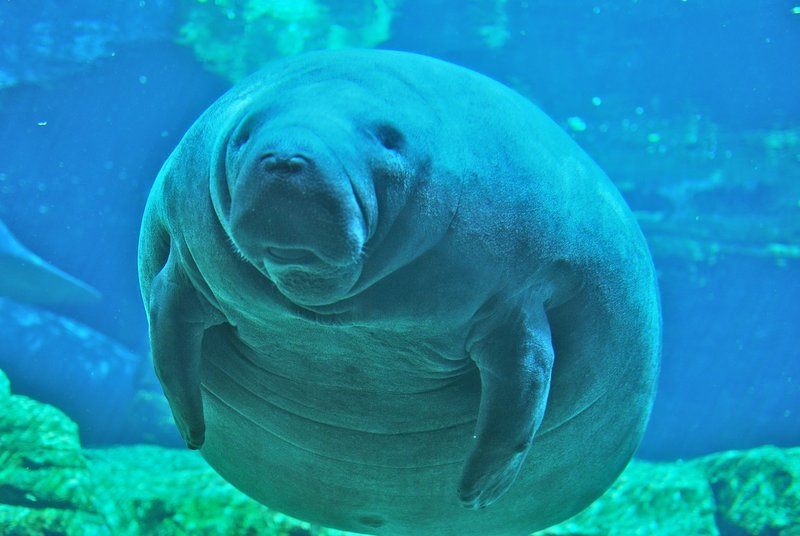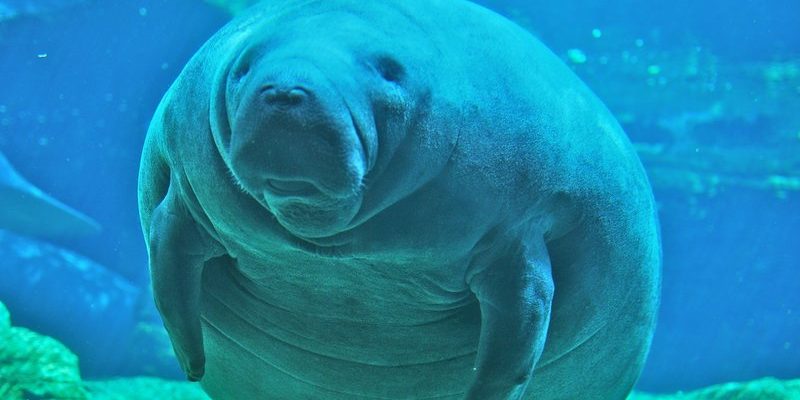
You might be wondering why these marine mammals are so special. Well, here’s the thing: manatees have existed for millions of years, and they’ve adapted in some unique ways that make them truly remarkable. From their diet to their social behavior, there’s a lot to uncover. Let’s explore ten cool things about manatees that will make you appreciate them even more.
1. They’re Herbivores
While many sea creatures hunt for their meals, manatees are strictly herbivores. They munch on a variety of aquatic plants, including seagrasses and algae. Imagine spending your days peacefully grazing under the water, enjoying the sunlight filtering down through the waves—sounds relaxing, right?
Manatees can consume up to 150 pounds of vegetation in a single day! This diet is not just about filling their bellies. By feeding on plants, they help maintain healthy seagrass beds, which are important for other marine life, too. Their grazing habits play a crucial role in balancing their ecosystem.
Interestingly, manatees have a slow metabolism, which means they can go several days without feeding. This might sound a bit boring, but it helps them thrive in their natural habitats, especially during colder months when food can be scarce.
2. They Have a Unique Way of Breathing
You might think of dolphins when it comes to marine mammals and their breathing, but manatees have their own unique style. Manatees can hold their breath for up to 20 minutes while they dive for food. However, they prefer to stay near the surface, where they can breathe easily.
When they do come up for air, they take short breaths through their nostrils located on the top of their snouts. This clever adaptation allows them to breathe without fully surfacing, making them less visible to potential predators. Honestly, it’s a smart survival tactic!
The next time you see a manatee, watch for those nostrils popping above the water. It’s a little reminder of how well-adapted they are to their environment.
3. Manatees Are Related to Elephants
Here’s something that might surprise you: manatees are closely related to elephants! They share a common ancestor that lived millions of years ago. While you won’t see manatees roaming the savannah, both species show similar traits, such as their large size and some aspects of their social behavior.
Like elephants, manatees have a thick skin that helps protect them from their environment. In fact, their skin can be rough and scarred from encounters with boats and other obstacles in the water. This shared ancestry reminds us of the connections between species and how evolution shapes life on Earth.
You might also notice that manatees have a strong social structure. They often live in small groups, sometimes referred to as “herds.” These groups help them navigate the waters and find food together, much like elephants do on land.
4. They Can Communicate
Manatees might look peaceful and quiet, but they have a variety of ways to communicate with each other. They use a combination of sounds, including chirps, whistles, and squeaks, to express different messages. Think of it as their own underwater language!
These vocalizations can carry for great distances underwater, allowing manatees to stay connected even when they’re spread out. Researchers believe these sounds help them communicate during mating or when they’re trying to find each other in murky waters.
So, next time you spot a manatee, imagine what they might be saying to one another. It adds a whole new layer of wonder to their behavior!
5. Manatees Can be Found in Fresh and Saltwater
While many people associate manatees with warm ocean waters, they can actually live in both fresh and saltwater environments. They’re often spotted in rivers, estuaries, and coastal areas. This versatility helps them thrive in various habitats.
In fact, the Florida manatee, one of the most well-known species, commonly inhabits the warm waters of Florida’s springs and rivers. These areas provide not just food but also protection from colder temperatures.
It’s fascinating to think about how adaptable these gentle giants are. Living in both types of water allows them to take advantage of different food sources and habitats, further ensuring their survival.
6. They Have a Slow Reproduction Rate
Unlike many animals that produce large numbers of offspring, manatees have a slower reproductive rate. Female manatees usually give birth to only one calf every two to five years after a lengthy gestation period of about 12 months.
This slow rate of reproduction poses challenges for their populations. If manatees face threats, such as habitat loss or boat strikes, it becomes difficult for their numbers to bounce back. Conservation efforts are crucial to protecting these gentle giants and ensuring their survival for future generations.
You might find it interesting that calves are born weighing around 60 to 70 pounds and are about 4 feet long! They rely on their mothers for nourishment and protection in their early years, making their bond incredibly special.
7. They Can Grow Quite Large
Manatees are hefty creatures, reaching lengths of up to 13 feet and weighing between 800 to 1,200 pounds! That’s like having a small car swimming alongside you in the water. Their large size makes them one of the biggest mammals found in the waters of North America.
Even with their size, manatees are surprisingly graceful swimmers. They can travel at speeds of up to 15 miles per hour in short bursts. It’s a bit like seeing a gentle giant sprinting through the waves, which is impressive considering their size!
Their bulk can be both a blessing and a curse. While they have fewer natural predators due to their size, they can be vulnerable to human activities, such as boating accidents.
8. They Play a Crucial Role in Their Ecosystem
You might be surprised to learn that manatees are more than just cute creatures; they play a significant role in their ecosystem. As herbivores, they help maintain the health of seagrass beds, which are vital habitats for many marine species.
By grazing on seagrasses, they promote their growth and keep the underwater environment in balance. Healthy seagrass beds provide shelter and food for various fish and invertebrates. So, when manatees do their thing, it benefits the entire aquatic ecosystem.
Additionally, their presence can influence the overall biodiversity within their habitat. So, every time you see a manatee, remember they’re contributing to the health of the ocean around them.
9. They Are Endangered
Despite their importance in the ecosystem, manatees face many threats and are considered an endangered species. Habitat loss, poor water quality, and boat collisions are some of the significant dangers they encounter.
Conservation efforts are essential for protecting manatees and ensuring their continued existence. Organizations work to raise awareness, rescue injured manatees, and monitor populations. It’s heartening to see so many people come together to advocate for these gentle giants.
If you ever have the chance to visit manatees in the wild, please remember to be respectful of their space. Keeping a safe distance and observing them quietly can help protect them and their natural behavior.
10. They’re a Symbol of Conservation
Finally, manatees represent the ongoing efforts in environmental conservation. Their struggles have sparked numerous campaigns to promote awareness around marine life protection. They remind us of the importance of taking care of our oceans and the creatures that inhabit them.
Many environmental groups use manatees as a symbol for broader conservation messages, highlighting the need to protect not just manatees but their entire ecosystems. They inspire people to participate in cleaning up waterways, advocating for better boating practices, and supporting legislation that benefits marine habitats.
As you learn about these unique animals, it’s important to remember that every small action can help protect their future. Whether it’s spreading awareness or supporting conservation efforts, we can all do our part to help these gentle giants thrive.
In conclusion, manatees are much more than just cute creatures floating in the water. They have fascinating behaviors, unique adaptations, and play a vital role in their ecosystems. By appreciating and learning about them, we can help protect these remarkable mammals and ensure they continue to grace our waters for years to come. So the next time you think of manatees, remember all the cool things that make them special!

